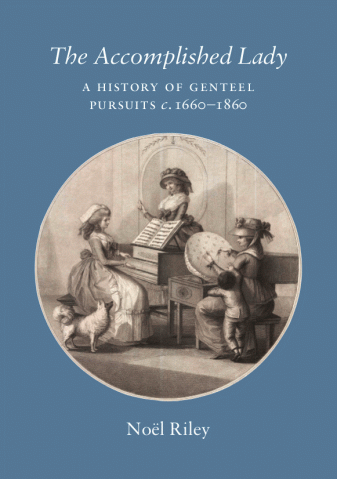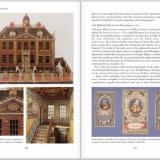Book Review: The Accomplished Lady: a History of Genteel Pursuits c. 1660–1860 by Noël Riley

The Accomplished Lady
Cover image of "The Accomplished Lady: a History of Genteel Pursuits c. 1660–1860" by Noël Riley.
Wednesday, 5th July 2017
This is a book of more substance than its subject matter may suggest. As one would expect from the Oblong press, the book is beautifully designed with numerous excellent colour illustrations and high quality printing and binding. Noël Riley’s very readable, but thoroughly researched and well referenced, text gives real insight into the lives of upper-class women in a patriarchal society. The period 1660 to 1860 is not a neat but arbitrary selection of two centuries; it covers the “long eighteenth century” (the period that interests our Georgian society) up to the point in Queen Victoria’s reign when women began to acquire more legal rights.
An unmarried lady would often have to rely on the charity of relatives; a married woman’s life was in theory more secure, but was not by any means easy. Aristocratic women were often required to make marriages at an early age (in 1679, Elizabeth Percy was married to Henry Cavendish at the age of eleven) for dynastic reasons, and then to go through multiple pregnancies to provide an heir. Childbirth was a risky business before the twentieth century and each pregnancy risked the mother’s life. A married woman could not be seen to work, as this would indicate her husband was unable to provide for her; instead she had the luxury of “leisure”. However leisure was not the same as idleness. Whilst upper class young ladies were expected to be educated they were not encouraged to become intellectuals. “... if some few get above their nurses’ instructions, our knowledge must rest concealed ...” wrote Lady Mary Wortley Montagu. Women were expected to busy themselves but were, in the words of Florence Nightingale, “never supposed to have any occupation of sufficient importance not to be interrupted”. What these occupations were is explored by Noël Riley in twenty-one chapters.
Domestic skills were part of a lady’s education, especially in the early part of the period discussed; partially as an insurance should she fall on hard times, but mainly to allow her to properly instruct her servants. Music, reading, dancing and sports were perhaps not unexpected pursuits for a lady but in this book we also discover a staggering range of crafts. Embroidery and lace making were raised to a high art; more surprisingly, some ladies excelled in stone carving, wood turning and metal work.
Whilst constrained by a patriarchal society, the intellect and creativity of upper class women found numerous, and sometimes unexpected, outlets. This book helps us to feel the sheer energy bubbling below the surface of what their men-folk might have considered to be merely pretty decorative objects. In short, this book, “The Accomplished Lady”, is like its subject, beautiful to behold on a superficial level; complex and intellectual on closer examination.
The Accomplished Lady: a History of Genteel Pursuits c. 1660–1860 by Noël Riley Pubilshed May 2017
Hardback, 468 pages, 245×172mm,
415 illustrations, ISBN 978 0 9575992 9 1,
UK£47.50, EU €60.00, US $65.00, OS £50.00
Distributed by D&M Heritage
 The Accomplished Lady sample page.
The Accomplished Lady sample page.

